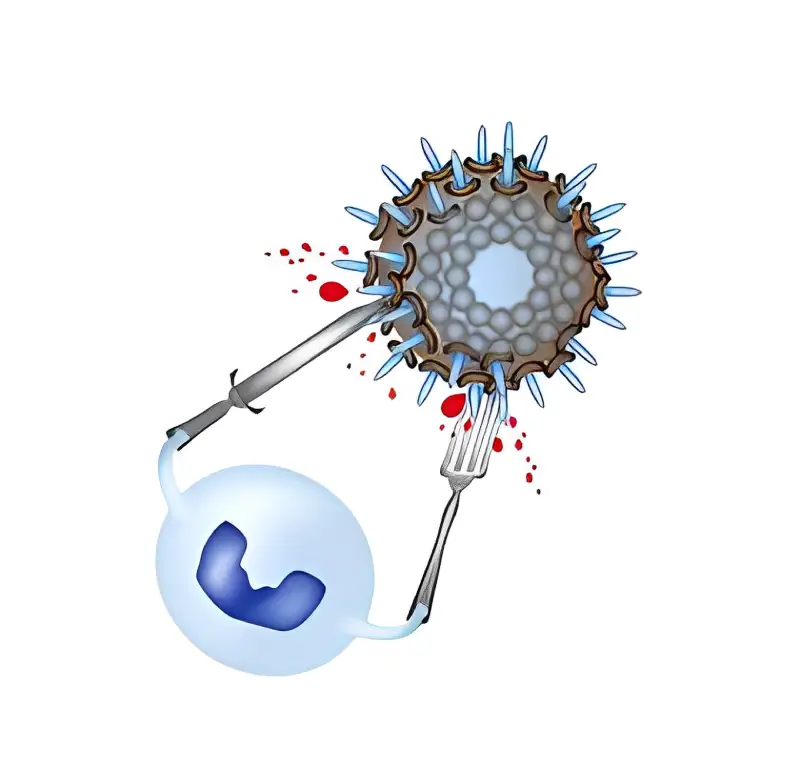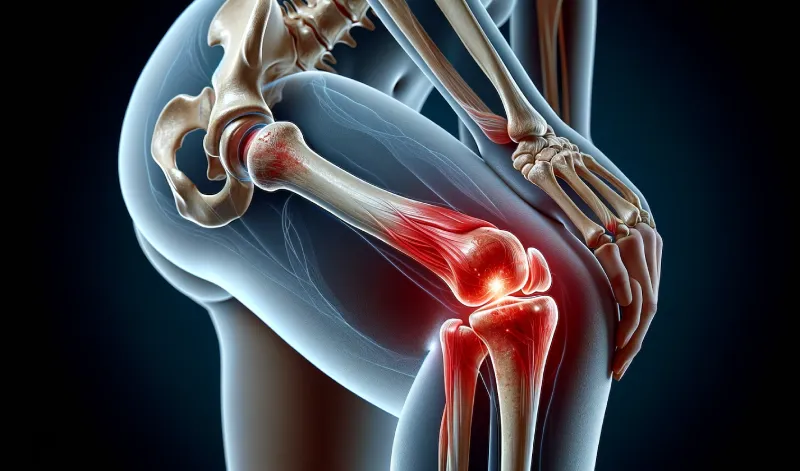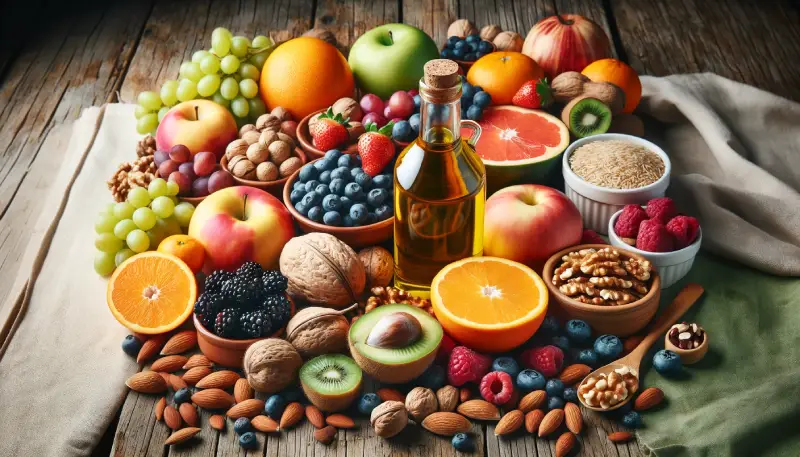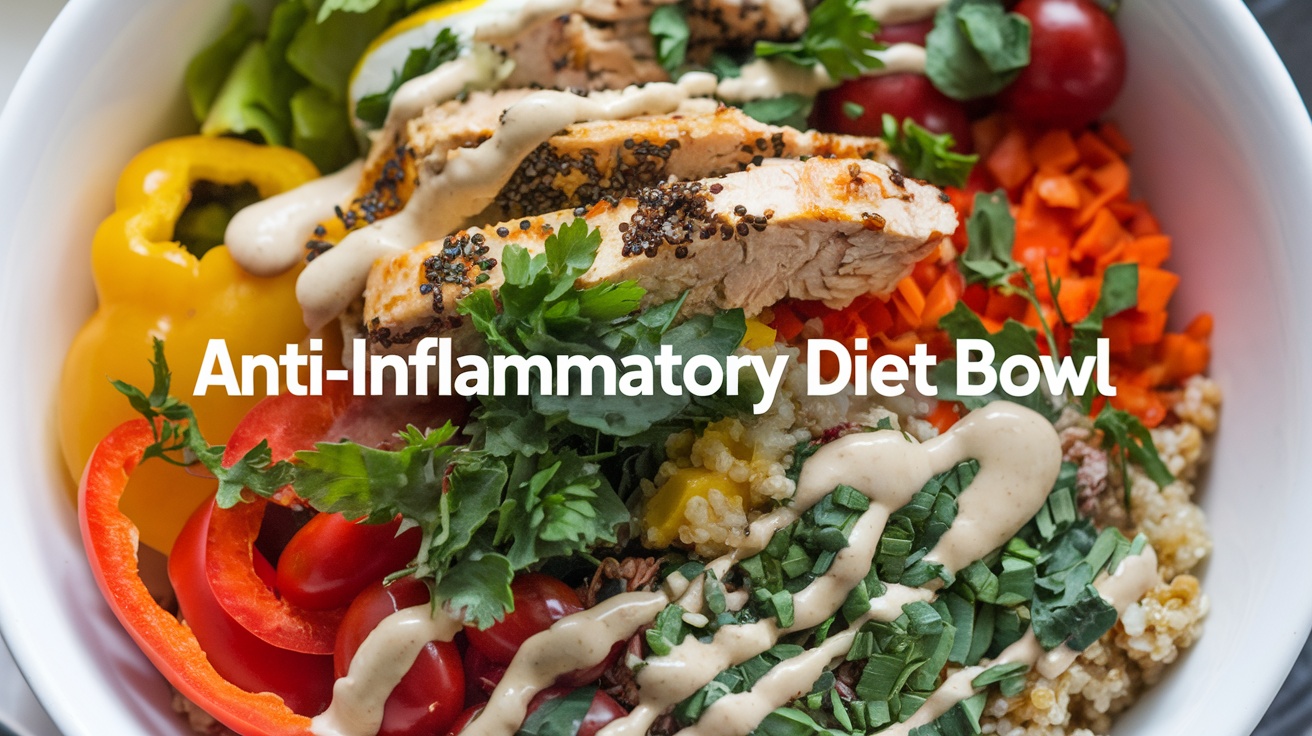The Anti-inflammatory Diet for Menopause Transition: An Effective and Sustainable Nutrition Plan
Hello ladies! I haven’t posted for a while!
I want to talk today about something super important but often overlooked: managing menopause with the right nutrition.
You see, during menopause, our bodies go through much more than just waving goodbye to Aunt Flow. Our trusty estrogen, a natural analgesic and bodyguard for our bones and muscles, starts to take a backseat.
And guess what? This can lead to more aches and pains and even ramp up our risk of chronic pain by a staggering 85%, something most of us never saw coming.
But there’s a way to make these transitions easier. I want to introduce you to an anti-inflammatory diet that’s not just another trendy fad. Like a life raft, it helps us get through the choppy waters of menopause.
It’s kind of like the Mediterranean diet’s cousin, filled with anti-inflammatory foods like colorful fruits and veggies, yummy seafood, whole grains, and legumes. Think of vibrant berries, juicy pomegranate, and even some spicy additions to give your meals an extra kick.
It’s not just about what we eat; it’s about what we aim to reduce. That means we’ll cut back on refined grains, added sugars, and processed foods.
Not only can this diet help reduce menopause symptoms such as hot flashes and mood swings, but it can calm our immune system, lowering pro-inflammatory molecules. In fact, research shows that this diet can reduce joint pain, stiffness, and fatigue in postmenopausal women by 41%.
The idea is to live a balanced, healthy life that keeps menopause’s ills at bay, to begin on a fresh and healthier path. Let’s look at some of the key elements of this diet and menopause inflammation relationship in greater detail.
What is Inflammation, and How Does It Relate to Menopause?
So first, let’s understand what inflammation is and how it relates to menopause so you’ll know how the anti-inflammatory diet can help. This way, you can make this diet plan a sustainable lifestyle change.
Inflammation is the body’s natural response to injury, infection, or toxins. It’s our immune system kicking into high gear to heal and protect us.

However, chronic inflammation occurs when the body’s immune response misfires. Instead of aiding in healing, it attacks healthy cells and tissues, causing damage.
As menopause progresses, estrogen and progesterone levels decrease, making our bodies more susceptible to inflammation. This hormone decline causes an imbalance in our body’s ability to regulate inflammation, leading to chronic inflammation during this transition.
Inflammation is an essential process for healing, but when it becomes chronic, it can lead to a range of health issues, such as cardiovascular disease, diabetes, and arthritis. Studies have shown that postmenopausal women often exhibit higher levels of proinflammatory cytokines, highlighting the direct correlation between menopause and inflammation.
The hormonal changes can cause women to gain weight in their abdominal area in the form of visceral fat. This abdominal obesity results in higher levels of inflammatory adipocytokines (Fat-derived cytokines) such as:
- C-reactive protein (CRP),
- IL-6, and
- Tumor necrosis factor α (TNFα).
These substances can cause inflammation throughout the body, increasing the risk of conditions like type 2 diabetes and even Alzheimer’s disease.
As estrogen and progesterone decline during menopause, the body’s natural inflammatory protection is removed, leaving women more susceptible to inflammation-related conditions. For instance, an increase in cytokines like IL-8 and IL-6 can cause irritability, mood swings, and even depression.

An increase in proinflammatory and adipogenic cytokines has been noted in the Bone Marrow Supernatant Fluid (BMSF), making women more prone to osteoporosis. It is essential to monitor inflammation levels during menopause to combat osteoporosis, a serious condition that can lead to bone fractures.
The increased risk of cardiovascular disease and insulin resistance are also among the chinks in our armor during menopause. Blood vessel linings become inflamed, and plaque begins to accumulate, raising the risk of cardiovascular disease.
Insulin resistance means the body is unable to use insulin effectively, resulting in high blood sugar levels that can lead to type 2 diabetes. Chronic inflammation plays a significant role in the development of insulin resistance, and women going through menopause are at higher risk due to the hormonal changes that occur during this phase.
Due to all these potential risks, adopting an anti-inflammatory and menopause-friendly diet is key to caring for our bodies during this transition.
Certain foods are notorious for causing inflammation, whether you’re menopausal or not. Yet there are also some real heroes in anti-inflammatory foods, which is why this diet plan revolves around them.
Switching to an Anti-Inflammatory Diet and How It Can Help?
The anti-inflammatory diet is a powerful tool to combat inflammation during menopause and beyond. This is a sustainable way of reducing chronic inflammation during menopause, with recipes and snacks full of natural anti-inflammatory foods.
Anti-inflammatory diets going viral in the health and wellness world nowadays are:
- Mediterranean diet
- Galveston diet
- Ketogenic diet
- Dietary Approaches to Stop Hypertension (DASH)
Rather than restricting calories, incorporating anti-inflammatory foods helps our hormones lose weight and improve our immunity. Even without chronic pain or other menopause symptoms, you should still consider adopting these eating habits into your life.
If switching is difficult for you, try one step at a time. The trick is to integrate foods that reduce inflammation and gradually eliminate the ones that trigger it.
I have researched and compiled the most effective plan to help you adopt an anti-inflammatory diet that suits your taste palate and lifestyle. The best part is it can be customized to meet the needs of women at different menopause stages.
The plan is to avoid gluten, dairy, white bread, white flour, processed foods, fried foods, and sugary drinks. Instead, switch to almond flour, grains, coconut milk, quinoa, and brown rice; whole foods such as fruits, vegetables, and lean proteins (chicken, fish, nuts); healthy fats like avocados and olive oil. And spices like turmeric, ginger, cinnamon, and garlic.
These foods are rich in vitamins, minerals, fiber, omega-3 fatty acid compounds, and phytochemicals that can reduce inflammation. For example, research shows that omega-3 fatty acids can help lower levels of pro-inflammatory molecules.
Fruits and vegetables are also vital to the anti-inflammatory diet as they contain antioxidants like beta-carotene and vitamin C, which help protect against cellular damage and inflammation. Incorporate a variety of colorful fruits and vegetables into your diet, such as leafy greens, berries, citrus fruits, and cruciferous vegetables.
The anti-inflammatory diet also emphasizes the importance of water intake and limiting alcohol consumption. Staying hydrated can help reduce inflammation, while excessive alcohol consumption can increase it.
An anti-inflammatory diet offers numerous significant advantages, including:
- Reduce inflammatory cytokine production
- Reduces belly fat associated with post-menopausal women while maintaining a healthy weight
- Keep your heart healthy by lowering blood pressure, reducing cholesterol, and minimizing heart disease risk
- Improve insulin sensitivity and reduce the risk of developing type 2 diabetes
- Reduce joint pain and stiffness associated with arthritis and osteoporosis risk by promoting bone health
- Reducing the risk of certain types of cancer, including breast, colon, and prostate cancer
- Reducing inflammation in the brain, improving cognitive function, and lowering the risk of neurodegenerative diseases like Alzheimer’s
- Improve gut health by promoting healthy gut bacteria and reducing gut inflammation.
- Improve mood and reduce symptoms of depression and anxiety.
What is An Ideal Anti-inflammatory Diet?
We are what we eat. The key principles of an anti-inflammatory diet include choosing organic and locally sourced whole, unprocessed foods rich in nutrients and antioxidants.
What to Eat:

Fruits:
Berries (blueberries, strawberries, raspberries, blackberries), citrus fruits (oranges, lemons), apples, and pears. Berries are rich in antioxidants, which help to neutralize free radicals that can cause inflammation. Grapes, cherries, and pineapple are also excellent sources of antioxidants and flavonoids with anti-inflammatory properties.
Vegetables:
Dark leafy greens (spinach, kale, collard greens), cruciferous vegetables (broccoli, cauliflower, Brussels sprouts), root vegetables (carrots, sweet potatoes).
Broccoli is another anti-inflammatory food packed with important nutrients and health benefits. It contains sulforaphane, a compound that has been shown to have anti-inflammatory properties and can help to reduce the risk of cancer. Broccoli also contains vitamins C and K, which are important for immune function and bone health.
Spinach, kale, and collards are also rich in antioxidants and a great source of calcium, which is essential for maintaining strong bones.
Tomatoes are another anti-inflammatory food that is rich in lycopene, a powerful antioxidant. Peppers, both sweet and hot, are also great sources of antioxidants and vitamin C, which helps to support the immune system.
Mushrooms, particularly shiitake and maitake, contain beta-glucans, which are a type of fiber that can help boost immune function and reduce inflammation.
Gluten-free Whole Grains:
Like quinoa, brown rice, oats, tapioca or cassava flour, and almond flour. Whole grains are a good source of fiber and contain important nutrients such as magnesium and selenium, which have anti-inflammatory properties.
Healthy fats:
Avocados, olive oil, nuts (almonds, walnuts), seeds (flaxseeds, chia seeds). They provide the body with important nutrients like omega-3 fatty acids.
Avocados are also rich in vitamin E, an antioxidant that can help reduce inflammation. They are also rich in fiber, potassium, and vitamins C, K, and B6, making them a nutrient-dense food supporting overall health and well-being.
Extra virgin olive oil is a healthy fat that is rich in monounsaturated fats and antioxidant oleocanthal, a compound that has similar anti-inflammatory properties to ibuprofen. Nuts and seeds are also great sources of healthy fats, fiber, and important nutrients like magnesium and zinc.
Lean proteins:
Chicken breast, fish (salmon, tuna, sardines, mackerel), tofu, beans, legumes.
Lean proteins are important for maintaining muscle mass and keeping you feeling full and satisfied. Fish, in particular, is a great source of omega-3 fatty acids that help reduce inflammation.
Fluids:
Plenty of water, coconut water, herbal teas. Staying hydrated is a must for overall health and can help to reduce inflammation in the body. If the plain water seems dull, adding a slice of lemon, lime, or a cucumber piece can make it more flavorful and add some extra antioxidants.
Coconut water is not just a refreshing drink but also a nutrient-packed fluid that replenishes your body with vital electrolytes. Loaded with antioxidants, it can help enhance your immune system, boost your metabolism, and prevent cell damage.
Herbal teas, on the other hand, are rich in anti-inflammatory properties that can soothe your digestive system, reduce stress, and ward off chronic diseases. Sipping on green tea, chamomile, ginger, or turmeric tea can do wonders for your overall well-being.

Green tea has been hailed for its numerous health benefits, with research showing it to be particularly effective in fighting diseases like cancer, obesity, and diabetes. A key component of green tea, EGCG, has been found to have anti-inflammatory properties.
EGCG is a polyphenol that can suppress the expression of inflammatory cytokines and enzymes, making it a promising tool for reducing inflammation and fighting cell damage. It also calms down the brain’s response to stress and aids in depression, anxiety management, and weight loss.
On the other hand, Chamomile tea contains flavonoids that can help relax your muscles and reduce inflammation. Ginger tea has similar anti-inflammatory effects and can also help with digestion and nausea.
Herbs and spices:
Turmeric, ginger, garlic, cinnamon. These herbs and spices have potent anti-inflammatory properties and can add flavor to your meals. Curcumin, the active compound in turmeric, offers powerful benefits as a plant-based antioxidant. With its anti-inflammatory superhero properties, it helps prevent degenerative conditions.
Also, do you know garlic has a powerful natural compound called diallyl disulfide? This compound has anti-inflammatory properties that can help reduce inflammation. A simple and natural remedy for sore, inflamed joints and muscles is garlic oil.
What to Limit: The Inflammatory Culprits
The most typical but also the most critical approach to an anti-inflammatory diet is to minimize the pro-inflammatory foods. What we should not eat:
Processed Foods:
What is processed food? Basically, processed foods are any foods that have been altered in some way during preparation.

Like packaged snacks, chips, cookies, processed meats (hot dogs, deli meats), frozen meals, margarine, fried foods, pastries, or sugar-sweetened breakfast cereals, processed foods are typically high in unhealthy fats, refined carbohydrates, added sugars, and preservatives, all of which can contribute to inflammation.
Swap them out for whole, unprocessed foods whenever possible. And reduce take-out and instant meals. I know this is not easy, especially when you are in a rush, hungry, busy, or tired after work. But, believe me, it’s worth taking the time to make a healthy meal. Try meal prepping at home using fresh ingredients and cooking meals in bulk to save time during the week.
Make small container jars of turkey slices, sugar snap peas, or cherry tomatoes ready-to-grab in the fridge. Prepack the trail mix and bring it with you in a plastic bag.
I did some research and found great healthy meal delivery services that use fresh, organic ingredients and can deliver prepared meals right to your doorstep. So you don’t have to worry about cooking or shopping.
Refined Grains:
These include white bread, pasta, and rice. Refined grains have been stripped of their fiber and nutrients during processing, leaving them with a high glycemic index, which can cause spikes in blood sugar levels, leading to inflammation.
Limit your intake of refined grains and choose whole grains instead.
Sugary Drinks:
Drinks like soda, energy drinks, fruit juices (except freshly squeezed), sweetened teas, and coffee beverages. These drinks typically contain large amounts of sugar or artificial sweeteners, both of which can lead to inflammation. The excess sugar in these drinks can lead to weight gain and contribute to inflammation.
Instead, try drinking plain water or herbal teas or infusing your water with fruits like lemon or berries for added flavor. Try green tea, which contains compounds called catechins, which are powerful antioxidants, a natural energy booster, and may help to reduce inflammation.
Any Sugar or Artificial Sweeteners:
Sugar is one of the most common pro-inflammatory foods. This includes white sugar, brown sugar, high-fructose corn syrup, agave nectar, and honey.

Sugar is everywhere. It’s hidden in foods you wouldn’t even think of as sweet, like ketchup and salad dressing. Excessive consumption of sugar can lead to inflammation in the body and contribute to chronic diseases like heart disease and diabetes.
Instead of adding sugars, use natural sweeteners like homemade sugar-free jams, pureed fruits, or stevia. It takes time to keep your taste buds trained to taste the natural sweetness of foods, but it becomes easier the more you eat real, whole foods, and you will certainly feel the astonishing difference.
Dairy:
This includes milk, cheese, yogurt, and ice cream. While dairy can be a good source of calcium and protein, it can also contribute to inflammation in some individuals. If you experience digestive issues or notice an increase in inflammation after consuming dairy products, consider limiting your intake or opting for
Alcohol:
Alcohol can disrupt gut health and increase inflammation in the body.
It can also contribute to weight gain and chronic diseases. Choose healthier options like sparkling water with a splash of fruit juice or herbal tea mocktails.
Red Meat:
While lean meats are a great source of protein in moderation, red meat, due to its high saturated fat content, can contribute to inflammation. Limiting red meat intake and incorporating lean or plant-based protein can help reduce inflammation.
Processed Cooking Oils:
These include vegetable, corn, sunflower, and soybean oils, high in omega-6 fatty acids that can promote inflammation. Instead, choose healthier options like olive, avocado, or coconut oil.
You don’t need to forbid yourself from enjoying these foods, but it’s important to consume them in moderation and focus on incorporating more anti-inflammatory options into your diet. Remember that small changes can make a big difference in reducing inflammation and supporting overall health and wellness.
Exercise also plays a vital role in reducing inflammation by promoting circulation, releasing endorphins- natural painkillers and mood boosters- and helping to reduce stress. Aim for at least 30 minutes of physical activity daily, whether a brisk walk, yoga, or weightlifting.
In addition to a balanced diet and regular exercise, getting enough sleep is crucial for reducing inflammation. When we sleep, our blood pressure naturally lowers, and our blood vessels relax. However, when we don’t get enough sleep, this normal decline in blood pressure doesn’t happen, potentially causing inflammation in the walls of our blood vessels.
Always listen to your body and make choices that work for you and your specific needs.
- Start with small changes; don’t try to overhaul your diet overnight completely
- Focus on whole, unprocessed foods and limit processed foods as much as possible
- Fill half of your plate with vegetables and incorporate plenty of antioxidant-rich fruits
- Mindful eating – take note of your body’s cues for hunger and fullness
- Stay hydrated by drinking plenty of water throughout the day
- Get at least 30 minutes of exercise per day
- Aim for a 7-9 hours sleep schedule
- Incorporate stress-reducing practices like meditation or deep breathing into your daily routine
- PSCE (Portion control, Stress management, Consistent exercise and Enjoyable movement)
- Don’t be too hard on yourself – it’s okay to indulge in moderation and treat yourself occasionally
- Surround yourself with a supportive community that shares your health goals and provides encouragement
Yummy Anti-inflammatory and Menopause-friendly Recipes and Snacks
I’ve got some super quick recipes for you that swap out inflammatory foods without compromising on taste. They are both anti-inflammatory and menopause-friendly, providing essential nutrients and superfoods to help boost energy, improve mood, and support long-term health:
Breakfast: Energy-Stabilizing Almond Pancakes
- Ingredients: Oats, almond flour, ground flaxseeds, cinnamon, baking powder, baking soda, unsweetened almond milk, eggs, vanilla extract, coconut oil for frying.
- Toppings: Maple syrup, blueberries, almond butter, and raw seeds.
- Benefits: Rich in magnesium, protein, fiber, vitamins, omega-3 fatty acids, and zinc, these pancakes help reduce hot flashes, regulate blood sugar, and keep hunger at bay.
Lunch: Stress-Fighting Quinoa Bowl
- Ingredients: Red bell pepper, broccoli, courgette, carrot, red onion, extra firm tofu, quinoa, olive oil.
- Sauce: Garlic, ginger, tamari or soy sauce, sesame oil, honey, arrowroot starch, or cornflour.
- Toppings: Sesame seeds, salt, fresh coriander, lime.
- Benefits: Packed with hormone-balancing tofu, stress-relieving quinoa, and antioxidant-rich vegetables. Quinoa is a superfood whole grain, high in B vitamins, vitamin E, iron, magnesium, and fiber.
Snack: Craving-Busting Dark Chocolate Chip Cookies
- Ingredients: Courgette, coconut oil, coconut sugar, maple syrup or honey, Greek yogurt, egg, vanilla extract, spelt or whole wheat flour, oats, baking powder, sea salt, baking soda, cinnamon, dark chocolate chips.
- Benefits: Antioxidant-rich courgette and dark chocolate (70% cacao) provide vitamin C, fiber, potassium, folic acid, magnesium, and serotonin-boosting properties.
Dinner: Healthy Cauliflower Mac and Cheese
- Ingredients: Cauliflower, stock, olive or coconut oil, onion, garlic, thyme, mustard, nutmeg, nutritional yeast, salt, pepper, lentil pasta, cheese, bread crumbs.
- Benefits: Cauliflower, a key ingredient, contains phytoestrogens to balance hormones and regulate estrogen levels. Lentil pasta offers a healthier alternative with fiber, protein, and iron.
These recipes are designed to help alleviate menopause symptoms and provide long-term health benefits. They focus on high-quality proteins, non-starchy carbohydrates, healthy fats, and fiber-rich foods.
How long does it take to see the benefits of an anti-inflammatory diet?
The time it takes to see the benefits of an anti-inflammatory diet can vary significantly from person to person, depending on various factors such as the individual’s baseline health status, the extent of dietary changes, and specific health goals.
Here are some general guidelines:
Short-Term Effects (Days to Weeks): Some people may notice changes in several days or weeks. This can include improved digestion, increased energy levels, and reduced bloating or gastrointestinal discomfort. For those with inflammatory conditions like arthritis, initial improvements in pain and stiffness might be noticeable within a few weeks.
Medium-Term Effects (Several Weeks to Months): More significant benefits, especially for chronic conditions, may take longer to manifest, typically several weeks to a few months. This can include a reduction in markers of inflammation in blood tests, improved blood sugar control, better cardiovascular health markers (like blood pressure and cholesterol levels), and weight loss if that’s a goal.
Long-Term Effects (Months to Years): The most profound health benefits, such as a reduced risk of chronic diseases (like heart disease, type 2 diabetes, and certain cancers), improved joint health, and better management of autoimmune conditions, generally require a sustained commitment to the diet over months to years.
It’s important to note that an anti-inflammatory diet is often part of a broader lifestyle approach, which includes regular physical activity, stress management, and adequate sleep. All these factors can influence how quickly and effectively you see the diet’s benefits.
Also, individual responses can vary greatly. Some people might see rapid improvements, while others may experience more gradual changes. It’s also crucial to ensure the diet is well-balanced and tailored to individual nutritional needs.
A Sustainable Lifestyle, Not a Temporary Diet: Get a Better Tomorrow
Let’s work together to make positive changes and achieve success. Let’s start this amazing transformation with a healthy, anti-inflammatory diet and lifestyle for better energy, mood, and disease prevention.
We can do it! Remember, every small step counts, and you can make positive changes for yourself.
The key is consistency, not perfection. By making gradual changes and incorporating healthy habits into our daily lives, we can reduce inflammation and improve our overall health in the long term.
So, let’s start today and continue on this journey towards a healthier, happier life filled with delicious, nutritious, and anti-inflammatory foods.







